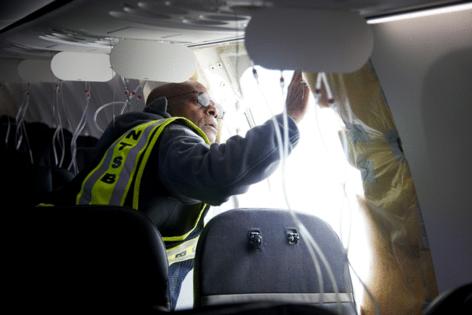NTSB casts blame on Boeing, FAA for 2024 midair blowout
Published in News & Features
U.S. safety investigators pointed to breakdowns in Boeing Co.’s manufacturing processes as well as poor oversight by the U.S. Federal Aviation Administration as key factors that led to a panel blowing off a 737 Max aircraft shortly after takeoff last year.
The midair blowout in January 2024, which left a gaping hole in the side of the plane operated by Alaska Airlines, didn’t result in any fatalities, but it plunged Boeing into crisis as regulators and policymakers scrutinized quality lapses at the planemaker’s factories. Early on in its investigation, the National Transportation Safety Board found the door-sized panel, known as a door plug, left Boeing’s factory in Renton, Washington, without four bolts meant to keep it in place.
During an NTSB meeting Tuesday to determine the probable cause of the accident, the investigator-in-charge of the probe, Doug Brazy, said there were several safety issues the agency identified connected to Boeing’s manufacturing processes. Among them were poor documentation practices, inadequate worker training and a history of unauthorized removals, similar to the door-plug work that ultimately led to it being reinstalled without the necessary bolts.
But the NTSB also placed blame on Boeing’s regulator, the FAA, whom it said had provided “ineffective oversight” of the manufacturer.
“I have lots of questions about where FAA was during all of this,” NTSB Chair Jennifer Homendy said at the start if the meeting. “The FAA is the absolute last barrier of defense when it comes to ensuring aviation safety.”
The NTSB session comes as Boeing is yet again in the spotlight after a 787 Dreamliner crashed in India earlier this month. The company had begun emerging from crisis mode after last year’s door plug mishap when the latest accident, which killed 241 passengers and crew as well as several more people on the ground, occurred on June 12. Investigators still haven’t drawn any conclusions on what caused that crash.
The NTSB isn’t the first to question the FAA’s oversight. The U.S. Transportation Department’s office of inspector general said in a report last year the regulator’s procedures for identifying and resolving production issues at Boeing were “not effective.”
Homendy said there were indications of quality control problems at the planemaker prior to the door plug incident in internal Boeing audits, employee reports and regulatory compliance reviews. “The safety deficiencies that led to this accident should have been evident to Boeing and to the FAA,” she said at Tuesday’s meeting.
The FAA said it will carefully evaluate the NTSB’s recommendations and noted it has made revisions to its oversight activities.
“The FAA has fundamentally changed how it oversees Boeing since the Alaska Airlines door-plug accident and we will continue this aggressive oversight to ensure Boeing fixes its systemic production-quality issues,” the regulator said in a statement.
Boeing said in a separate statement that it will review the NTSB’s final report and recommendations. The company also said it continues “to work on strengthening safety and quality across our operations.”
Prior to the NTSB meeting, most of the circumstances leading to door plug blowout had already come to light. The fuselage panel had been removed during the manufacturing process to repair damaged rivets and wasn’t reinstalled correctly, investigators determined shortly after the mishap.
The door plug’s removal wasn’t properly documented and an NTSB aerospace engineer, Pocholo Cruz, said the agency still doesn’t know the identity of the worker or team of workers in Boeing’s factory who handled the removal and reinstallation. He also said the NTSB doesn’t know what happened to the missing bolts and suggested they may have been discarded.
Another NTSB engineer, Clint Crookshanks, said that Boeing and key supplier Spirit AeroSystems Holdings Inc. have finished engineering work on a redesigned door plug to prevent an incident like the one in 2024 from recurring. The changes include the addition of lanyards that will hang from the panel’s bolts so that a mechanic will know if they’re in place or not. The redesign still needs to be certified, but Boeing intends to begin installing the new door plugs in 2026, the engineer said. It also plans to issue a service bulletin to retrofit older planes, he said.
Boeing confirmed the details but said the timeline is an estimate because the redesign needs to be certified.
Following the midair blowout, the FAA expanded its oversight of Boeing and hired more aviation safety inspectors. The NTSB’s Cruz said Tuesday there are now 55 inspectors compared to 34 prior to the door plug mishap.
The FAA also capped production of the 737 Max at 38 planes per month.
Boeing voluntarily slowed down manufacturing last year to address quality issues, but is now nearing output close to the FAA’s limit. The company’s chief executive officer, Kelly Ortberg, has said he’s aiming to have the cap lifted later this year — if the regulator agrees. The planemaker has also said it’s making progress on the action plan it submitted to the FAA, detailing steps the company would take to improve its methods and reduce defects on parts coming from Spirit.
©2025 Bloomberg L.P. Visit bloomberg.com. Distributed by Tribune Content Agency, LLC.







Comments